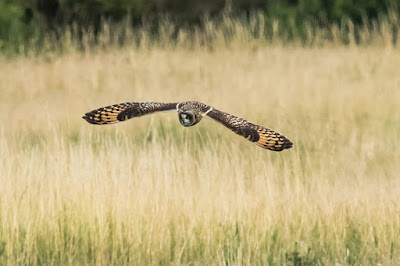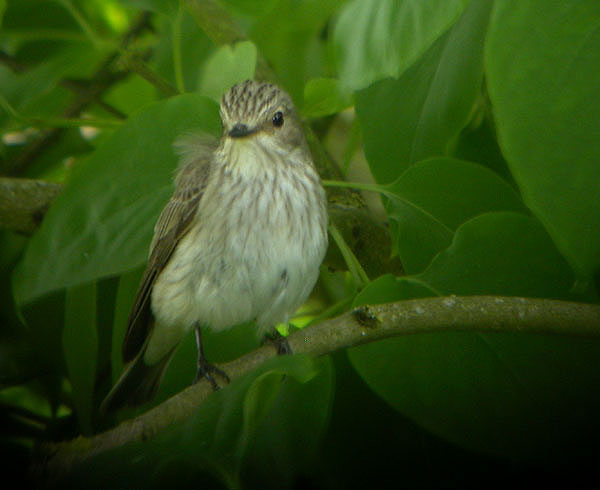A trip north to Berwick, on the border of England and Scotland was required to collect not only my daughter but her racing bike. I needed a bike rack to fit to the car and knew just the man to contact. A few days later I made a rendezvous with Terry on an early Monday morning in the car park at Otmoor, where we soon had the bike rack attached to the back of the Audi.
With this accomplished we decided to take advantage of what was promising to be a pleasantly mild and sunny day and indulge ourselves with a gentle foray into Long Meadow to look for migrant Common Redstarts. Long Meadow does not on first sight cast a favourable impression that it harbours any good birds, indeed any birds at all. It is also hard going as the ground, although now grassed over is rutted and pitted from when cattle rove over it in winter and consequently the churned ground makes progress on foot a bit of a chore.
Between the tall hedges and occasional trees that mark Long Meadow's perimeter small hawthorn trees and bushes are randomly dotted across the grassland like miniature islands. They always appear devoid of birdlife but at this time of year patience and a little local knowledge sometimes brings its rewards.
The secret of finding the redstarts in Long Meadow is two fold. The first is to get there first. If you do and there are redstarts present then they will not have been disturbed by other birders and will not have sought more distant and undisturbed areas with the consequence they are easier to find. The second is to have infinite patience and not go from tree to tree, bush to bush trying to flush them. Stand quietly and unobtrusively at the side of the meadow with your silhouette masked by the background vegetation and just watch across the meadow to the various small trees and bushes.
This was our strategy. We stood quietly and listened. It's a not unpleasant experience and often it's good for the soul to be still for a while. A redstart's anxiety call was clearly ringing out from the other side of the meadow but rather than heading for it we remained motionless. Minutes passed by and we quietly chatted about how nice it was on a Monday morning to be standing here free of the cares of work and enjoying our retirement.
After a while it seemed we became accepted, almost absorbed into the natural framework of our surroundings, the alarm call from the redstart ceased and slowly small shapes and movements materialised in the trees and bushes. There were birds present after all. A small dark form dropped down from the base of a tree into the long grass and then returned to the tree with a flash of orange. It disappeared briefly then re-appeared. We looked through our bins but sadly the orange signified not the hoped for redstart but the breast of a Robin. Another dark shape moved jerkily, low down through the tree but it was only a Wren. We were not downhearted though, as it is infinitely pleasurable picking out the odd bird shape and identifying it, always with the hope that the next shape or movement will signify a redstart.
Then in an instant, there was a redstart, a female, in the same tree, perched half way up at the very edge. The epitomy of neurotic energy as its constantly shivering rust orange tail imparted an edginess and the impression that you better be quick or it will be gone. In fact it remained for a few minutes moving to various positions on the outside of the bush and then finally it flew fast and low to another tree and was gone.
We gently walked along and looked across to where it had flown and caught another brief glimpse of it but then on the opposite side of the tree there came another movement, higher up this time and there was a male redstart, beautiful in the morning sun, with rich orange red underparts, pale grey upperparts and a black and white face. A real treat.
Male Common Redstart c Terry Sherlock
|
We stood and admired it and although undoubtedly aware of our presence it considered us distant enough to be of no threat. Nonetheless the redstarts here never remain long in one spot and true to form it soon flew off.
Seeing them this way is so rewarding, even thrilling. They are shy and nervous birds that require the application of careful thought as to how best to get to see them and then when the application bears the fruit of a glorious male sitting boldly in the sun it is an intensely gratifying experience.
We walked slowly onwards moving deeper into the Long Meadow, keeping to the edge and stopping regularly to wait and listen. Redstarts were now calling in anxiety all around, their melancholy two note hoooweeet call coming from various trees in the meadow but they were always invisible. Their anxiety call is very similar to that of both Willow Warbler and Chiffchaff and requires some practice to differentiate. Even now I sometimes get it wrong but to my ears the call is slightly bolder, longer and louder, less high pitched, presumably because a redstart is more substantial than the much smaller Willow Warbler and Chiffchaff.
A Common Whitethroat flew high and fast between two trees, diving into the thorny depths before repeating the process as it flew onwards to yet another tree. A Lesser Whitethroat, dapper grey of head and silky white of throat gleamed in the sun against the dark green bramble leaves it was frequenting and a sulphur headed male Yellowhammer tizzed its way across the meadow.
We stood once more, waited and sure enough other redstarts appeared as they gained confidence about our presence and so we gently, almost serenely progressed to the end of Long Meadow counting in total between eight to ten redstarts. It was impossible to be sure of exactly how many because of their elusive nature.
A lone Raven high, very high in the sky, betrayed itself with guttural croaks as it flew above us and a Common Buzzard soared up from the wood, rising in the warm air of mid morning. Turning we walked back along the other side of the meadow and another pair of redstarts flirted along some fence posts before seeking sanctuary deep in the hedgerow.
We wandered back though the dry summer grass stalks as grasshoppers sprang from our feet, leaping in a profusion of startled motion. We chatted inconsequentially and felt pretty good about our successful morning. So good in fact that when we got back to the car park neither of us wanted the day to end quite now, so we opted for another meander, this time out to The Pill in search of Whinchats. The adjacent firing range was thankfully silent, as on Mondays no shooting takes place, so consequently no red flag was flying, banning access to The Pill. We slipped through the unlocked metal gate and followed the bridleway along the hedgeline that forms the border of Otmoor Reserve.
Terry saw the small fawn brown bird first, sat on top of the hedge, halfway out to The Pill, displaying that relaxed vigilance that Whinchats seem to adopt. The very opposite of the behaviour displayed by this morning's redstarts. I find all the chats attractive and appealing birds. For me it's a combination of things; their demeanour, their plumage patterns, the fact that they are predominantly migrants and I suppose their comparative seasonal scarcity here on Otmoor. All meld into an irresistible delight.
I stood back as Terry slowly edged closer to it. The Whinchat showed little alarm but finally it was one step too close and it flitted off and away but Terry had captured a nice image.
Whinchat c Terry Sherlock
|
We carried on towards the area of The Pill, the wide fields to our right giving the usual sense of spacious abandonment and emptiness that is such a feature of this location. Further on we came across two more Whinchats sharing the hedgeline with a couple of Common Whitethroats, the former showing a preference for the topmost sprays of the hedge and an all round panoramic view whilst the whitethroats skulked in the hedge bottom, peeking out from behind a leafy density.
Three Marsh Harriers, the colour of dark chocolate with a splash of cream on their heads floated across the reserve and were lost to view behind the hedgerow as they flew low into Greenaways. It was now approaching noon and unknowingly we had covered a lot of rough ground since we first set off early this morning. Two young Kestrels hunted insects in the field as, pleasantly tired, we set off back to the car park, taking the Roman Road on the slim chance of seeing a last Brown Hairstreak.
There was little sign of either hairstreaks or the usual attendant butterfly enthusiasts at the beginning of the Roman Road but we eventually came across one person who had just arrived from Cambridge and he asked if he was in the best place to see the hairstreaks. 'Yes, this is the spot, just hang around here and one should show up sooner or later. Check the thistle heads as they prefer to feed on them but it may be some time before you see one. Good luck anyway'. 'Thanks I will do that' he replied and wandered off. Terry and myself walked on twenty or so metres. I looked at another spray of pale mauve thistle heads and there on one of the heads was that familiar but always thrilling sight of a small brown triangle. Thin and fragile as tissue paper. A Brown Hairstreak, nectaring no more than four feet from the ground.
I called out to the butterfly enthusiast. 'Do you still want to see a hairstreak? Over here!' I pointed and he came running. 'Where is it?' 'Right there'. 'Where, I cannot see it?' I moved my finger to within an inch of the untroubled butterfly. A pristine male, just hatched, it was a glory of orangey browns and white spider scrawl lines on its underwings. 'Oh thank you so much. It's beautiful. My first ever'.
'You're welcome'.
It had been that kind of a day. Nothing could go wrong and indeed it hadn't.
Many thanks to Terry Sherlock for the images of the Whinchat and Common Redstart












































